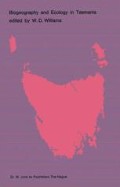Abstract
Any large land mass combining within its boundaries a considerable range of topographic systems of a size commensurate with its area can be assumed to be a suitable region in which to appraise the processes tending to increase and the opposing ones tending to decrease the range of an animal species. Weatherley & Lake (1967) therefore examined the distributions of various teleost species introduced into Australian waters, in relation to the characteristics of their life cycles and their environments, to determine whether their observed ranges might be explained as a result of such limiting factors as absence of spawning substrates, unfavourable stream gradients and climatic extremes.
Access this chapter
Tax calculation will be finalised at checkout
Purchases are for personal use only
Preview
Unable to display preview. Download preview PDF.
Bibliography
Allen, K. R. 1935. The food and migration of the perch (Perca fluviatilis) in Windermere. J. Anim. Ecol. 4: 264–273.
Allen, K. R.1951. The Horokiwi Stream: a study of a trout population. Fish. Bull. N.Z. No. 10.
Chapman, D. W.1967. Production in Fish Populations. In: S. D. Gerking(ed.) The Biological Basis of Freshwater Fish Production. Oxford, Blackwell.
Chapman, D. W.1968. Production. In: W. E. Ricker(ed.) Methods for Assessment of Fish Production in Fresh Waters. I.B.P. Handbook No. 3. Oxford, Blackwell. Cuvier, G.1834. The Animal Kingdom. London, Whittacker.
Guiler, E. R.1955. Observations on the hydrology of the River Derwent, Tasmania. Pap. Proc. R. Soc. Tasm. 89: 65–80.
Hasler, A. D. & Bardacii, J. E. 1949. Daily migrations of perch in Lake Mendota, Wisconsin. J. Wildl. Mgmt. 13: 40–51.
Hergenrader, G. L. & Hasler, A. D.1967. Seasonal changes in swimming rates of yellow perch in Lake Mendota as measured by sonar. Trans. Am. Fish. Soc. 99: 373–383.
Huet, M.1954. Biologie, profils en long et en travers des eaux courants. Bull. fr. Piscic. 175: 41–53.
Lake, J. S.1957. Trout populations and habitats in New South Wales. Aust. J. mar. Freshwat. Res. 8: 414–450.
Lutz, P. L.1972. Ionic and body compartment responses to increasing salinity in the perch Perca fluviatilis. Comp. Biochem. Physiol. 42 (3A): 711–717.
Maxwell, H.1904. British Freshwater Fishes. London, Methuen.
Nall, G. H. 1930. The Life of the Sea Trout. London, Seeley.
Nicholls, A. G. 1957. The Tasmanian trout fishery. I. Sources of information and treatment of data. Aust. J. mar. Freshwat. Res. 8: 451–475.
Nicholls, A. G.1958a. The Tasmanian trout fishery. II. The fishery of the north-west region. Aust. J. mar. Freshwat. Res. 9: 19–59.
Nicholls, A. G.1958b. The Tasmanian trout fishery. III. The rivers of the north and east. Aug. J. mar. Freshwat. Res. 9: 167–190.
Nicholls, A. G.1958c. The population of a trout stream and the survival of released fish. Aust. y. mar. Freshwat. Res. 9: 319–350.
Nicholls, A. G. 1958d. The egg yield from brown and rainbow trout in Tasmania. Aust. y. mar. Freshwat. Res. 9: 526–536.
Nicholls, A. G.1961. The Tasmanian trout fishery. IV. The rivers of the south and south-east. Aust. J. mar. Freshwat. Res. 12: 17–53.
Pearsall, W. H.1949. The English Lakes and their development.New Biol. 6: 9–28.
Roughley, T. C.1951. Fish and Fisheries of Australia. Sydney, Angus and Robertson. Schaeperclaus, W.1933. Textbook of Pond Culture. Berlin. (Trans. F. Hund, U.S. Fish. Leafl. Washington, No. 311.)
Schindler, O.1957. Freshwater Fishes. London, Thames and Hudson.
Seeley, H. G.1886. The Fresh-water Fishes of Europe. London, Cassell.
Siltamaa, E. 1956. Finnish Fish and Fisheries. E. G. Segerstråle (ed) Limnologorum Conventus. XXIII. ( Handbook for the Congress.) Helsinki.
Taaning, A. V.1944. Experiments on meristic and other characters in fishes. I. On the influence of temperature on some meristic characters in sea trout and the fixation period of these characters. Meddr Kommn Havunders. (Fiskeri) 11(3).
Weatherley, A. H. 1958. Tasmanian farm dams in relation to fish culture. C.S.I.R.O. Div. Fish. Oceanogr. Tech. Paper No. 4: 1–24.
Weatherley, A. H.1959a. Growth, production, and survival of brown trout in a large farm dam. Aust. y. mar. Freshwat. Res. 9: 159–166.
Weatherley, A. H. 1959b. Some features of the biology of the tench Tinca tinca (Linnaeus) in Tasmania. J. Anim. Ecol. 28: 73–87.
Weatherley, A. H.1962. Notes on distribution, taxonomy and behaviour of tench Tinca tinca (L.) in Tasmania. Ann. Mag. nat. Hist. Ser. 13, 4: 713–719.
Weatherley, A. H. 1963a. Thermal stress and interrenal tissue in the perch Perca fluviatilis (Linnaeus). Proc. zool. Soc. Lond. 141: 527–555.
Weatherley, A. H.1963b. Zoogeography of Perca fluviatilis (Linnaeus) and Perca flavescens (Mitchill) with special reference to the effects of high temperature. Proc. zool. Soc. Lond. 141: 557–576.
Weatherley, A. H.1972. Growth and the Ecology of Fish Populations. London, Academic Press.
Weatherley,A. H.& Lake,J. S.1967. Introduced fish species in Australian Inland Waters. In:A. H. Weatherley(ed.) Australian Inland Waters and their Fauna: Eleven Studies. Canberra, Australian National University Press.
Williams, W. D.1964. Some chemical features of Tasmanian inland waters. Aust. J. mar. Freshwat. Res. 15: 107–122.
Author information
Authors and Affiliations
Editor information
Rights and permissions
Copyright information
© 1974 Dr. W. Junk b.v., Publishers, The Hague
About this chapter
Cite this chapter
Weatherley, A.H. (1974). Introduced Freshwater Fish. In: Williams, W.D. (eds) Biogeography and Ecology in Tasmania. Monographiae Biologicae, vol 25. Springer, Dordrecht. https://doi.org/10.1007/978-94-010-2337-5_7
Download citation
DOI: https://doi.org/10.1007/978-94-010-2337-5_7
Publisher Name: Springer, Dordrecht
Print ISBN: 978-94-010-2339-9
Online ISBN: 978-94-010-2337-5
eBook Packages: Springer Book Archive

